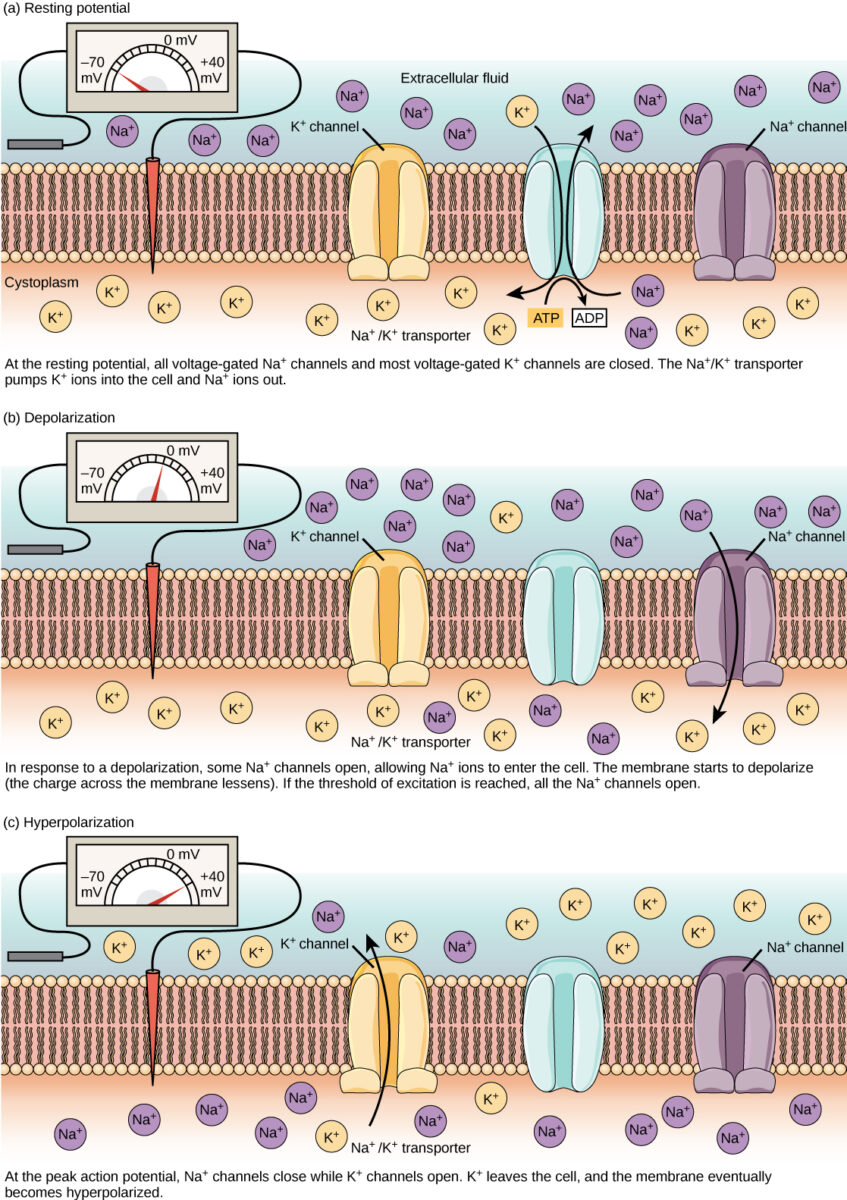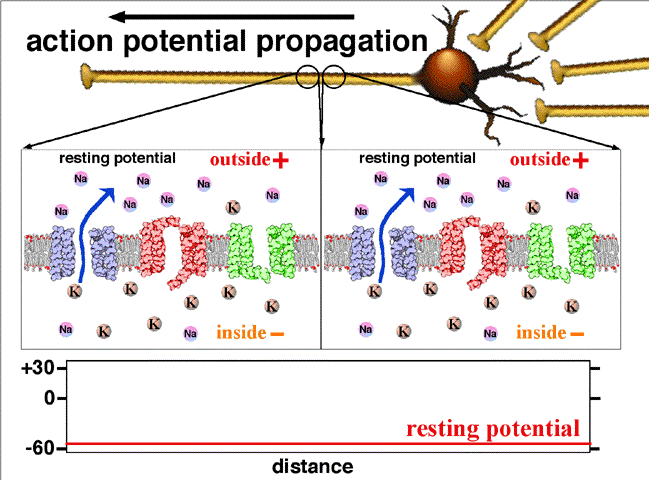The membrane potential is the difference in electric charge between the interior and the exterior of a cell. All living cells maintain a potential difference across the membrane thanks to the insulating properties of their plasma Plasma The residual portion of blood that is left after removal of blood cells by centrifugation without prior blood coagulation. Transfusion Products membranes (PMs) and the selective transport of ions across this membrane by transporters. There are 3 types of potential: resting membrane potential, equilibrium Equilibrium Occurs when tumor cells survive the initial elimination attempt These cells are not able to progress, being maintained in a state of dormancy by the adaptive immune system. In this phase, tumor immunogenicity is edited, where T cells keep selectively attacking highly immunogenic tumor cells.This attack leaves other cells with less immunogenicity to potentially develop resistance to the immune response. Cancer Immunotherapy potential, and action potential. Membrane potential helps to generate action potential, and these action potentials act as carry-and-relay signals to the CNS and brain Brain The part of central nervous system that is contained within the skull (cranium). Arising from the neural tube, the embryonic brain is comprised of three major parts including prosencephalon (the forebrain); mesencephalon (the midbrain); and rhombencephalon (the hindbrain). The developed brain consists of cerebrum; cerebellum; and other structures in the brain stem. Nervous System: Anatomy, Structure, and Classification for performing a specific movement or action.
Last updated: Dec 28, 2024

Ion channel activity at rest, during depolarization and hyperpolariztion
Image: “Ion channel activity at rest, during depolarization and and hyperpolariztion” by Robert Bear and David Rintoul. License: CC BY 4.0Used to calculate the equilibrium Equilibrium Occurs when tumor cells survive the initial elimination attempt These cells are not able to progress, being maintained in a state of dormancy by the adaptive immune system. In this phase, tumor immunogenicity is edited, where T cells keep selectively attacking highly immunogenic tumor cells.This attack leaves other cells with less immunogenicity to potentially develop resistance to the immune response. Cancer Immunotherapy potential at a given concentration difference of a permeable ion across the cell membrane Cell Membrane A cell membrane (also known as the plasma membrane or plasmalemma) is a biological membrane that separates the cell contents from the outside environment. A cell membrane is composed of a phospholipid bilayer and proteins that function to protect cellular DNA and mediate the exchange of ions and molecules. The Cell: Cell Membrane.
$$ V_{eq}= \left ( RT/zF \right )ln\left ( X_{o} /X_{i}\right ) $$Veq =
equilibrium
Equilibrium
Occurs when tumor cells survive the initial elimination attempt These cells are not able to progress, being maintained in a state of dormancy by the adaptive immune system. In this phase, tumor immunogenicity is edited, where T cells keep selectively attacking highly immunogenic tumor cells.This attack leaves other cells with less immunogenicity to potentially develop resistance to the immune response.
Cancer Immunotherapy potential for the ion X
R = gas constant (8.314 joules per kelvin per
mole
Mole
Nevi (singular nevus), also known as “moles,” are benign neoplasms of the skin. Nevus is a non-specific medical term because it encompasses both congenital and acquired lesions, hyper- and hypopigmented lesions, and raised or flat lesions.
Nevus/Nevi)
T = temperature in kelvin (K = °C + 273.15)
z = charge on the ion (+1 for Na+, +2 for Ca2+, −1 for Cl−)
F = Faraday constant (96,485 Coulombs per
mole
Mole
Nevi (singular nevus), also known as “moles,” are benign neoplasms of the skin. Nevus is a non-specific medical term because it encompasses both congenital and acquired lesions, hyper- and hypopigmented lesions, and raised or flat lesions.
Nevus/Nevi)
Xi = intracellular concentration (millimolar or mM)
Xo = extracellular concentration (millimolar or mM)
The resting membrane potential can be considered the average of the equilibrium Equilibrium Occurs when tumor cells survive the initial elimination attempt These cells are not able to progress, being maintained in a state of dormancy by the adaptive immune system. In this phase, tumor immunogenicity is edited, where T cells keep selectively attacking highly immunogenic tumor cells.This attack leaves other cells with less immunogenicity to potentially develop resistance to the immune response. Cancer Immunotherapy potentials of all the ions that permeate in and out of a cell, modified by the relative permeability of a cell to those ions.
$$ E_{m}=\frac{RT}{F}ln\left ( \frac{P_{K}\left [ K^{+} \right ]_{out}+P_{Na}\left [ Na^{+} \right ]_{out}+P_{Cl}\left [ Cl^{-} \right ]_{in}}{P_{K}\left [ K^{+} \right ]_{in}+P_{Na}\left [ Na^{+} \right ]_{in}+P_{Cl}\left [ Cl^{-} \right ]_{out}} \right ) $$Em: membrane potential (in volts, or joules per coulomb)
Pion: the
selective permeability
Selective permeability
The Cell: Cell Membrane for the specified ion (in meters per second)
[ion]out: concentration of the specified ion outside the cell (in
moles
Moles
Primary Skin Lesions per cubic meter)
[ion]in: intracellular concentration of the specified ion (in
moles
Moles
Primary Skin Lesions per cubic meter)
R: the ideal gas constant (joules per kelvin per
mole
Mole
Nevi (singular nevus), also known as “moles,” are benign neoplasms of the skin. Nevus is a non-specific medical term because it encompasses both congenital and acquired lesions, hyper- and hypopigmented lesions, and raised or flat lesions.
Nevus/Nevi)
T: the temperature in kelvins
F: Faraday constant (coulombs per
mole
Mole
Nevi (singular nevus), also known as “moles,” are benign neoplasms of the skin. Nevus is a non-specific medical term because it encompasses both congenital and acquired lesions, hyper- and hypopigmented lesions, and raised or flat lesions.
Nevus/Nevi)

Nerve action potential
Image: “Action potential propagation animation” by John Schmidt. License: CC BY 4.0